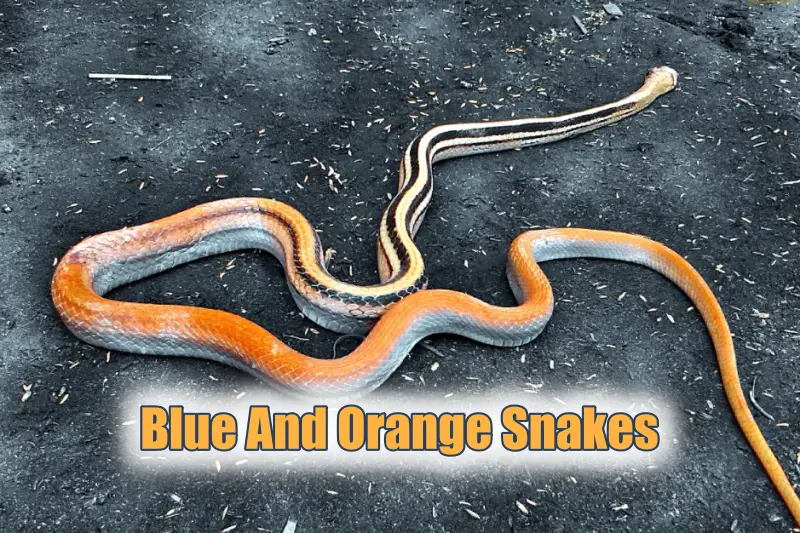Up until lately, I could picture myself referring to anything other than a snake as cute! However, one specimen stood out: the San Francisco Garter Snake, a natural artwork. I came across its images while abstractly browsing the internet, and I was drawn to its beauty so much that I decided to look up additional pictures of these exquisitely patterned blue and orange snakes and compile a bunch for our readers.
Without any further delay, let’s begin with our list of 10 gorgeous and unusual species of orange and blue snakes, along with an identification guide. Rest assured as we will not skip the fascinating facts about them for sure.
List of 10 Blue And Orange Snakes With Identification Guide
1. San Francisco Garter Snake
- Scientific name- Thamnophis sirtalis tetrataenia
- Size: Adult can grow to a length of 46 – 140 cm
- Location: Endemic to California
The San Francisco garter snake is an endangered species that can only be found in a few isolated regions of the San Francisco Peninsula, spanning from the northern part of Santa Cruz County to the boundary of San Mateo County.
Although they used to be found in stock ponds and tiny marshes in impressive numbers, there are currently just ~1500 of them remaining. A contributing factor, aside from the loss of habitat resulting from urbanization, is the illegal capturing by collectors who are attracted to its stunning beauty.
This garter snake is undoubtedly the most attractive snake you will spot in California. Its fiery orange head and stunning bluish-black and red stripes are attractive enough, but the belly and mild stripes have the most subtle turquoise wash to enhance its charm.
The pictures alone speak volumes about what a magnificent serpent it is.
2. Blue Malayan Coral Snake
- Scientific name- Calliophis bivirgatus
- Size: Up to 1.8m
- Location: Southeast Asia- Brunei, Indonesia, Malaysia, Singapore, Thailand, and Burma.
This coral snake is medium-sized with a lean build. Its belly, tail, and head are all crimson. Its back is typically a beautiful dark blue to black in hue, with a broad blue or white stripe along each side.
This rare snake inhabits the leaf litter of primary and secondary forests, eating other snakes as food. It typically runs away when approached, but occasionally, it will stand there and display its red tail in an attempt to defend itself.
It makes sense that these snakes have venom glands reaching up to 25% of their body length, which occasionally leads to human deaths. Although in contrast to other members of the same family, its venom contains enough of an inflammatory response, hypotension, and rapid paralysis without being neurotoxic.
3. Striped Coral Snake
- Scientific name- Calliophis nigrotaeniatus
- Size: Maximum 58.7cm
- Location: Indonesia & Malaysia
Coral snakes are often the prettiest, and this one is no different. However, since they may be really poisonous, it is best not to let it flatter you enough to drop your cautiousness.
The occurrence of alternate orange and dark blue stripes on its belly, and throughout the length of its body gives the banded Malaysian coral snake, also known as the striped coral snake, a good reason for its name.
4. Banded Malayan Coral Snake

- Scientific name- Calliophis intestinalis
- Size: Maximum about 50cm
- Location: Borneo, Indonesia, Java, and Malaysia
Another Malayan coral snake is on the list! This one is quite similar to the last one, belonging to the same genus. It is crucial to handle this tiny species carefully because it possesses a potent neurotoxic venom, and several human fatalities were recorded from it. They live in wooded settings and occasionally overgrown gardens and parks.
It is a ground-dwelling snake that primarily eats other snakes. Its fiery tail and reddish-orange vertebral stripe help us to identify it. While in danger, the snake flips over to show off its striking black-and-white pattern on the underside.
5. The Red-Headed Krait
- Scientific name- Bungarus flaviceps
- Size: Up to 2.1 m
- Location: Malaysia, Singapore, Thailand, South India, and Indonesia (Sumatra)
The red-headed krait, a large and highly poisonous serpent belonging to the Elapidae family, is both a sight to capture and an immediate threat. Despite its fatal venom, this snake rarely bites people.
They have a striking and unique appearance, consisting of a blue-black body with a low-lateral, narrow, bluish-white stripe and a brilliant orange head and tail.
The red-headed krait has big, smooth scales, which accounts for the fascinating, glossy appearance overall.
6. Red-Headed Reed Snake
- Scientific name- Calamaria schlegeli
- Size: About 40cm
- Location: Brunei, Indonesia, Malaysia, and Singapore
Not to confuse with the red-headed krait, the red-headed reed snake is a much smaller, non-venomous species. They have an attractive bright orange-red head, and no coloration on the tail.
Under intense light, their dark dorsal color displays a blue-green iridescence, while the ventral surface is grey-white. Thus, these are the identifying characteristics of this species.
This species of reed snake lives in the forest and digs. It eats small invertebrates like worms and occasionally comes out at night to capture insects.
7. Spiny-Bush Viper
- Scientific name- Atheris Hispida
- Size: males grow up to 29 inches; females grow up to 23 inches.
- Location: Central and East Africa
Central Africa is home to this rare species of viper. Perhaps you’re wondering why this snake appears in our list of orange and blue snakes. Since it seems strange to be here.
The question seems obvious, and so does the answer. This is due to the fact that these spiny bush vipers can be brown, green, blue, or a mix of the three colors. Additionally, orange tints are frequently seen on their scales. So, this stunning yet threatening serpent is an odd hero on the list.
Typically, solitary and nocturnal, spiny bush vipers bask throughout the day on top of flowering bushy plants. They also have the ability to hang upside down from tree branches and climb reeds and stalks.
8. The California red-sided garter snake
- Scientific name- Thamnophis sirtalis infernalis
- Size: Females: 90–100 cm, while males: 65-75 cm
- Location: Northern California
If you ever come across this one in California, do you think you could get close to it? Yes! You can, since garter snakes do not pose an immediate risk to people. With a few exceptions, none of the species are sufficiently threatening to humans despite having weak venom that can cause anaphylaxis in some bite victims.
Thamnophis sirtalis infernalis exhibits crimson in patches rather than a single red stripe along its dorsal line, unlike the San Francisco garter snake.
In other words, this species has a fundamental pattern of three lines: a row of black spots or blotches emerging in a stripe-like pattern and yellow or blue stripes over a body that is mostly red.
Definitely a wonderful sight. Isn’t it?
9. Sunbeam Snake
- Genus- Xenopeltis
- Size: 1-1.3 m
- Location: China, Vietnam, Southeast Asia, Philippines, and Indonesia
Would you ever consider having a pet snake? Let me use this species on our list to persuade you!
The small, non-venomous, often docile sunbeam snakes (genus Xenopeltis) are so beautiful, low-maintenance, and easy-going that people prefer keeping them in their household!
Its iridescent scales, which appear brown, pink, or purplish in the dark but flash with compelling, metallic color in the light, giving it a brilliant blue and orange tint, are the primary cause for its popularity. Look how charming these are!
As one of the oldest species of living reptiles, sunbeam snakes differ greatly from newer species in terms of their skeletal makeup.
10. Coral-bellied Ring-necked Snake
- Scientific name- Diadophis punctatus pulchellus
- Size: 25-38cm
- Location: the United States, central Mexico, and south-eastern Canada
This snake stands out from others due to its primary blue-gray color, unique orange pattern over its underside, and most noticeable feature—an orange band around its neck.
Due to their nocturnal and timid nature, ring-necked snakes are rarely sighted during the day. It is the only species in the genus Diadophis, and we may not observe many different features and behaviors among its sub-species.
Though they are indeed poisonous, they may only release a weak venom that rarely results in death or major illness or injury in most humans, but its bite should be avoided for obvious reasons.
Are Blue And Orange Snakes Venomous?
Even while some blue and orange snakes are incredibly harmless and non-venomous, some of them can be life-threatening because of their highly potent venom.
The venom of the Blue Malayan Coral Snake, for instance, is extremely toxic and can result in instant paralysis. In contrast, two extremely timid and non-poisonous reptiles are the coral-bellied Ring-necked Snake and the red-headed reed snake.
Conclusion
Blue and orange snakes are among the most visually attractive and fascinating species found in the colorful world of reptiles. Even though their charm immediately impresses us, we should always exercise caution around them because some of them have deadly bites.
Nonetheless, a few of those creatures on our list are so amiable, kind, and attractive that they are suitable for keeping as pets. On this note, we wrap up the post so that our eager readers can understand it and continue the conversation about those incredible serpents found all across the world.
FAQs
Q1. Which snake is blue in color?
Ans. There aren’t many blue snakes in the world because blue isn’t a pigment that many creatures naturally possess. But One such snake is a blue pit viper. It is a majestic blue variety, yet incredibly rare and highly poisonous. It can be found in Indonesia’s Lesser Sunda Islands and eastern Java. It’s also one of the most common culprits for poisonous bites in Bali; however, green varieties are frequently spotted rather than blue ones.
Q2. Is Blue Krait poisonous?
Ans. The blue krait or Malayan krait, with the scientific name Bungarus candidus, is a highly poisonous species of snake. It is one of the world’s deadliest snakes! The likelihood of dying from a blue krait bite ranges from 60 to 70 percent if left untreated.
Q3. Do purple snakes exist?
Ans. Much to our amazement, Yes! There are purple snakes in the world! Even so, it is pretty unlikely that you will ever come across one. Numerous species in the Amblyodipsas genus are referred to as purple-glossed snakes. For example, one such purple snake is the venomous rear-fanged snake Amblyodipsas ventrimaculata, also known as the Kalahari purple-glossed snake, which is native to Namibia, Botswana, northern Zimbabwe, and western Zambia.
Also Read:
- All Snakes in Georgia, According to Georgia Department of Natural Resources (With Identification & Habitat)

Anjali Prasad, a B. Pharm. graduate who works as a content writer for HowItSee, is based in Delhi. Except for her, not many people take the typical road from healthcare to writing. Her love of writing stemmed from her involvement in the college literature society and her early journaling at the age of 7. Hence, the love of learning and the spirit of exploration are what drew her to this career. You can find her on common social media like Instagram.
